What is BITCOIN?
Internet-Money
Max Kaye
What does money do?
Medium of Exchange
Store of Value
Unit of Account
Medium of exchange
"I can give Alice some value."
Alice --(house)--> Max
Max --(money)--> Alice
Alice --(money)--> Bob
Bob --(apples)--> Alice
Store of value
"I can hold it and it doesn't go away."
Alice --(house)--> Max
Max --(money)--> Alice
Alice --(money)--> Bob
Bob --(apples)--> Alice
Unit of account
"I can price both houses and apples"
Alice --(house)--> Max
Max --(money)--> Alice
Alice --(money)--> Bob
Bob --(apples)--> AliceProperties OF Money
Fungible (units are alike)
Divisible (can represent big or small values)
Portable
Durable
Recognisable
Scarce
Non-consumable
Money is an agreement
Australian Dollar → Legal Foundation
Bitcoin → Mathematical Foundation
Both Money
What is BitcoIN?
3-and-a-bit answers:
- The 'coin' - economic (abstract)
- The network - software/hardware (implementation)
-
The protocol - data structure (theoretical)
- The network (again)
Economics - The Bitcoin
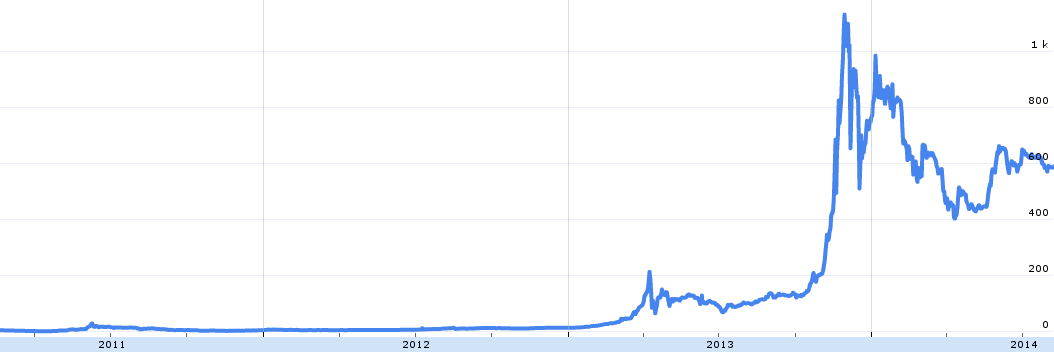
Exchange Rate
Currently: ~$590 USD
Doubling time: ~4 months
Payment Processor Comparisons
| Name | Volume | # Transactions |
|---|---|---|
| Western Union | 4x | 10x |
| Paypal | 10x | 100x |
| Visa | 300x | 3000x |
Doubling time (# transactions):
~11 months
Merchants
| Name | # Merchants |
|---|---|
| Bitpay | 35,000+ |
| Coinbase | 35,000+ |
Doubling Time: ~5-6 months
New Adopters:



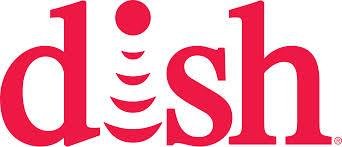
(August 2014)
Users
| Name | # Users |
|---|---|
| Blockchain | 2,000,000 |
| Coinbase | 1,500,000 |
Doubling Time: ~6 months
(August 2014)
SOFTWARE & Hardware - The Network
-
Addresses and Wallets
-
Transactions
-
Double Spends
-
Global Tx Ledger
Addresses
An address looks like 157AGN5ztnE8ZXZFDX6iaAiHptWBvNFrSa
A wallet is a collection of addresses
Privacy comes from
using unique addresses
for every transaction
Transactions
Simply a description, not a movement
"Bob sends 9.95000000 XBT to Alice"
... with addresses:
1PGo2Yx9FSNAUqLGhBZijeCoyrLRsPtrY4
sends 9.95000000 XBT to
1NFdNzV9R8YfVV3ferjpRywZkfcXy783pj
Double Spends
If transactions are just descriptions...
Why can't I lie?
Blockchain - Global Ledger
Answer:
Everyone knows EVERY transaction
Updated (approximately) every 10 minutes with a new 'block'
(block: a list of transactions)
PROTOCOL
Data Structures:
Transactions
Blocks
The Blockchain
Transactions
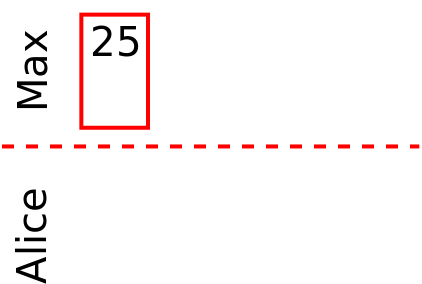
Next: Send to self and split three ways
TRANSACTIONS
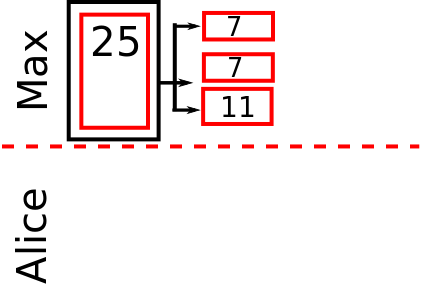
Next: Send to Alice
Transactions
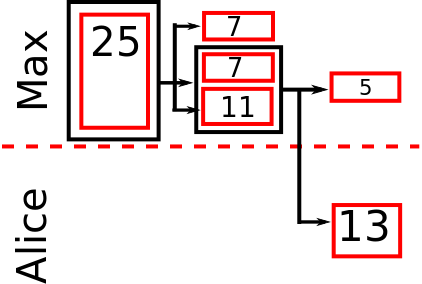
Blocks
Contain a list of transactions
(and a little metadata)
Also require a special
'coinbase' transaction
This is how new coins are introduced
The Blockchain
Proof of work
Idea:
try one thing
many times
until a 'special' solution is found
Because the solution is random,
if a 'special' solution can be found,
the number of attempts can be estimated.
The Blockchain
Proof of Work
Each block has a proof of work attached
(dependant on the contents of that block)
Quick to validate
Hard to generate
No Short-cuts
The Blockchain
Each block points to the previous block
Which creates a chain:
... ← b30 ← b31 ← b32 ← b33 ← b34 ← ... ← b315300
Able to estimate how many attempts
in the ENTIRE chain
Consensus rule:
pick the chain with the most attempts
The Blockchain
Self regulating production time
Constant production rate
(predictable inflation)
Set the number of attempts needed
via the 'difficulty'
Back to the network
(Time for game theory)
Network - Miners (Auditors)
↘
↘
↘
↘
Low difficulty / high price creates profit potential
More miners
Faster blocks
Difficulty increase
Profit potential decreases
Network - Miners (Auditors)
Bitcoin reward and price at equilibrium
↓
Price increase
↓
Higher profit potential from mining
↓
More miners
↓
Reward and price at new equilibrium
Network - Miners (Auditors)
No profit potential with current hardware
↓
Design & produce new custom hardware
↓
More attempts for same cost
↓
New profit potential
Network - Miners (Auditors)
Approaching current limits of technology
↓
Cannot make smaller, faster chips
↓
Market will respond by making chips cheaper and more accessible
Difficulty Reaction
| Date | Difficulty |
|---|---|
| May 2013 | 12 million |
| August 2014 | 19 billion |
Doubling Period: ~1.5 months
Difficulty and Hashrate (linear)
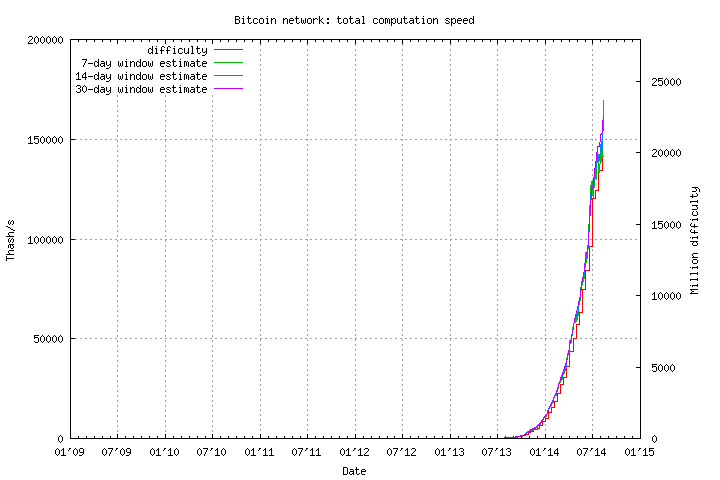
Difficulty and Hashrate (Log)
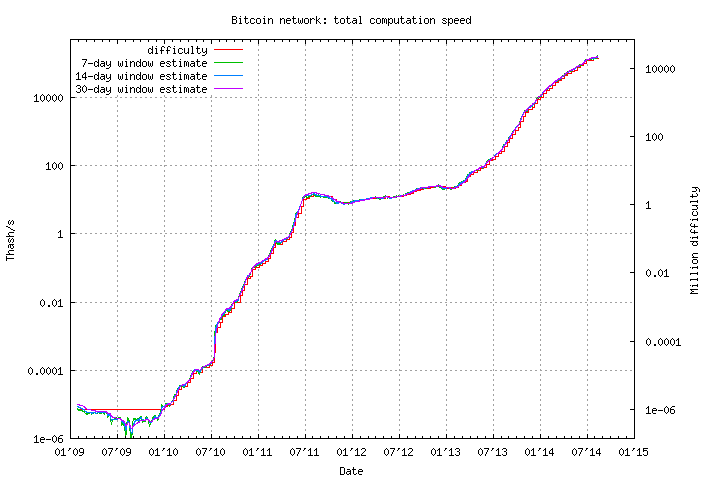
Comparison (For Sha256)
10 THash/s for $10,000
Equivalent to 25,000 GPUs
$10,000 buys you:
S1: 500,000 word dictionary with 2,000 permutations per word
S2: All 10 character alpha-numeric combinations
| Medium | S1 | S2 | |
|---|---|---|---|
| GPU | 0.15s | 1,200 days | |
| ASIC | 0.0001s | 0.97 days |
Thanks
Questions
bitcoin-intro-internet-money
By Max Kaye
bitcoin-intro-internet-money
A brief intro to bitcoin
- 1,604



